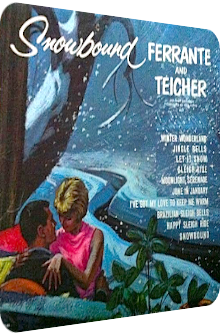
Ferrante & Teicher
Snowbound
1962
Take a look at the front artwork, the title, the opportunity – ’tis the season – and everything is said and done right from the get-go: this is one of them pesky Christmas albums, eh? Enter a world of consumerism… and pain. Absorb the sarcasm and turn it into cynism, it warms the heart in a different manner. In reality though, Snowbound is quite the attractive exception to the rule. Played by renowned pianists and friends since their early childhood days Arthur “Art” Ferrante (1921–2009) and Louis Teicher (1924–2008), the gentlemen see themselves surrounded by a fully equipped orchestra, as is regularly the case in their albums of the 60’s.
Released on United Artists Records in 1962, the same year that brought us the duo’s Exotica opus Pianos In Paradise, the LP features the usual array of 12 tracks but has more to offer than one might imagine. While all songs encapsulate a wintery feeling with lots of diaphanous tambourines, glitzy triangles, cavernous vibraphones and stereotyped bells, these devices are not necessarily used to create a festive feeling at all costs. Snowbound thankfully branches out, is about romance, sees its strings and horns create glacial landscapes rather than shopping windows that are exclusively based on consumerism. Due to the inclusion of a Space-Age choir in five tunes and the addition of two original Ferrante & Teicher productions, even an album such as Snowbound is reviewed in-depth.
Ferrante & Teicher’s hibernal panorama opens in a clear-cut Space-Age fashion, at least timbre-wise once the mixed choir starts to chant the title of the opener in a galactic fashion, sprinkling stardust and cinematic visions all over the chords: Snowbound by Clarence Kehner and Russell Faith is the magic moment. Pianos sprinkle downwards, tambourines chink like a dog sleigh, the female portion of the choir is replaced by the gentlemen on a rotating basis and vice versa. Best of all is the somewhat intimate photometry, with the strings holding back most of the time, making room for the pianos, double bass and pristine devices to glint. Sammy Cahn’s and Jule Styne’s adjacent Let It Snow! features a fitting exclamation mark, and the pianists fulfill that wish in this instrumental by transforming it into aqueous-gelid piano prongs, hued in amethystine violins and perennial orchestra bells.
Leroy Anderson’s 1948 hit Sleigh Ride meanwhile is made of a gorgeous punctilio that is already embroidered in the original, but augmented here by warmhearted keys and vitreous mallet devices. Firecrackers, a haze of purified tambourines and moving patterns make this a genuinely attractive piece. While John Blackburn’s and Karl Suessdorf’s Moonlight In Vermont celebrates the return of the choir in a dedicated orchestra-accentuated piano arrangement that is detached from the wintry theme via nocturnal polyfoliage and percolating string anhydrides, Ferrante & Teicher’s own Skaters Waltz is a glacial zoetrope of glassy vibraphone dew drops, alkaloidal string cascades and a vividness of the pianists that breaks the hoarfrost and makes this a viridian landscape alright that is finished with James Pierpont’s ultra-famous and eternal hit Jingle Bells. This tune would have been a great closer – as it is the pendant to Exotica’s Aloha Oe – but is only an intermediary endpoint. Like it or hate it, but the duo at least revs up the old melody via the fast tempo alone. Add a pinch of Honky Tonk ascriptions and ligneous keys in-between the pizzicato cotton candy, and you’ve yourself got a decent arrangement after all.
Side B offers more crystalline coruscation of the celebratory kind, but surprisingly ventures into more eclectic material… seen from an Easy Listening context, that is. The scope is also broadened and moves away from the typical winterfest. Irving Berlin’s I’ve Got My Love To Keep Me Warm is not yet the best case in this tendency’s point, but kicks off things nicely in almost four minutes. A tad too chintzy and antediluvian with a cheesy performance by the choir, there is romance and verve injected in every chord. Only the aureate bells and sizzling triangle-based snowflakes make a certain difference. Likewise, Felix Bernard’s Winter Wonderland is equally prone to capture the festive moods. Galloping beats, downwards-spiraling magenta strings and whitewashed piano potassium among the caproic vocals make this a standardized hit.
However, it is getting interesting after all: a rendition of Percy Faith’s Brazilian Sleigh Bells turns out to be the second-fastest rooster of the roster, enchanting with sylphlike strings and jumpy piano convolutions as well as convulsions; even brass layers are on board. Glenn Miller’s and Mitchell Parish’s Moonlight Serenade then slows things down but enchants with a truthfully Space-Age-worthy performance of the choir. Humming along to the seraphic strings and majestic pianos, it fuels the warmth but retains a certain galactic attitude. Similarly, with Leo Robin’s June In January the duo invokes Summer via golden piano chords and less percussion scrimshaw ornamentation before their own Happy Sleigh Ride finishes the album with a tachycardia tunnel vision of mountainous horns, staccato keys, “hey!” chants and a double bass on speed. The glockenspiels, bells and whistles round off a perfectly sped-up blast.
While the period of consumerism known as Christmas is put forward for decades now and people see gingerbread and related decorations in stores as early as September now, Christmas albums face the same problem which potentially turns into oppression and resistance sooner or later. I mean, how far can you take things, how many weeks can you put this season forward from a marketing perspective? Questions like these cannot be answered eruditely here – as can anything! – but they serve as the base and background for the analysis of themed albums. Luckily, Ferrante & Teicher’s Snowbound is not exclusively about Christmas per se, and so you find glacial sparklers on here that loosen their ties to this festivity. Moonlight In Vermontor June In January are perfect examples of a wintery blend that gains access to these classics. The first of these examples isn’t even a specific winter song after all, all the while the latter composition shows that no marketing buff is brave enough to link the Occidental Christmas season to June, let alone January, ho ho ho!
In the end, Snowbound is a tasty work of icicles and similar floes, juxtaposing the kernel of snugness with the expectations of the crowd. The front artwork says it all: it is a romantic album in the first place, one which ought to be shared with a loved one. What it doesn’t tell is the stupefyingly fast-paced and varied material: Brazilian Sleigh Bells and Happy Sleigh Ride are smoking-fast pieces and not your typical sanctuary of languor. At the end of the day – and the year – it turns out that Snowbound is one of those LP’s that works best in December, no surprise here, but can also prolong its half-life period to the adjacent months of the new year. Recommended to Space-Age fans and available on vinyl, CD, streaming services and as a download.
Exotica Review 399: Ferrante & Teicher – Snowbound (1962). Originally published on Dec. 20, 2014 at AmbientExotica.com.
